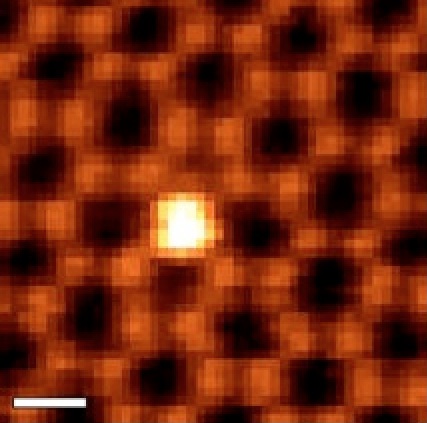A research team from the Oak Ridge National Laboratory (ORNL) of the Department of Energy has demonstrated that point defects in graphene are helpful in transferring atomic-scale data by integrating electrons with light, paving the way to develop quicker and compact electronic devices.
 Electron microscopy at Oak Ridge National Laboratory has demonstrated that silicon atoms (seen in white) can act like "atomic antennae" in graphene and transmit an electronic signal at the atomic scale. (credit: ORNL)
Electron microscopy at Oak Ridge National Laboratory has demonstrated that silicon atoms (seen in white) can act like "atomic antennae" in graphene and transmit an electronic signal at the atomic scale. (credit: ORNL)
The findings of the study are reported in a paper titled ‘Atomically Localized Plasmon Enhancement in Monolayer Graphene’ in Nature Nanotechnology. Point defects in graphene comprise silicon atoms in place of single carbon atoms of the nanomaterial. According to Juan-Carlos Idrobo, co-author of the paper, this proof-of-concept study has explained that a two-atom silicon wire in graphene is capable of transforming light into an electronic signal and then converting the signal again into light.
The research team revealed this unique behavior of the point defects in graphene by utilizing aberration-corrected scanning transmission electron microscopy to picture optical-like signals or plasmon response. The silicon atoms operate like atomic-scale antennae, thus improving graphene’s local surface plasmon response and forming an atomic-scale prototypical plasmonic device. The electron microscope used for the study is a component of the Shared Research Equipment User Facility of ORNL.
According to Wu Zho, coauthor of the paper, researchers are able to fabricate smaller plasmonic devices using metals but only down to 5-7 nm. In this experiment, the research team was able to create plasmonic devices with sizes down to an atomic scale. Besides its microscopic study, the research team used theoretical first-principles calculations to verify the stability of the point defects.